Yes, you absolutely can fly to Cuba from America! Despite the long and complicated history between the United States and Cuba, travel is indeed possible for US citizens. As an American myself, I can tell you firsthand that stepping onto Cuban soil is not just a dream, but a reality. I remember the slight nervousness I felt at immigration, passport in hand, wondering if everything was truly in order. But let me reassure you, if you follow the guidelines, you can experience the vibrant culture and beauty of Cuba.
For decades, Cuba has been a destination shrouded in restrictions for Americans, dating back to 1959. However, despite these limitations, many Americans have found ways to visit, navigating both legal and less formal routes. The key is understanding the current regulations and ensuring you’re traveling within the permitted categories.
When I approached the immigration agent, passport in hand, I couldn’t help but feel a mix of emotions. A desire to connect with Cuba, a hint of apology for the political complexities, and pure excitement to explore. “Stamp?” the agent asked, a question familiar to those aware of Cuba’s and Israel’s policy of offering passport stamps only upon request. The thought crossed my mind – should I get a Cuban stamp? Could it cause issues with US immigration down the line? But the desire to commemorate the journey won out. “Sí,” I replied confidently. The stamp landed in my passport, and with a simple “Welcome to Cuba,” my adventure began.
Thinking about planning your own Cuban escape? Let’s dive into everything you need to know about flying to Cuba from America in 2024, making your travel planning straightforward and stress-free.
Can Americans Travel to Cuba? Quick Questions Answered
Before we get into the details, let’s address some of the most pressing questions Americans have about traveling to Cuba:
Is American travel to Cuba allowed? Yes, Americans can legally travel to Cuba. Obtaining a Cuban travel visa is a relatively simple process, and direct flights from the United States are readily available. It’s more straightforward than you might imagine.
Can US citizens use credit cards in Cuba? Unfortunately, no. US-issued credit cards and debit cards do not work in Cuba. Attempting to use them could lead to your bank freezing your account. It’s essential to understand the specific regulations regarding handling money in Cuba as an American.
Is internet access available in Cuba? Yes, there is internet in Cuba, but it’s not as widely accessible or as seamless as in the US. Typically, you’ll need to purchase a Wi-Fi card for hourly access and connect at designated hotspots. Navigating internet access in Cuba requires a bit of planning.
Is it possible to fly to Cuba from the US? Absolutely. Nonstop flights to Havana are available from numerous US cities, including Miami, New York, and Atlanta. However, to board these flights, possessing a valid Cuban visa is mandatory.
Did the Trump administration complicate Cuba travel for Americans? While the Trump administration eliminated the “people-to-people” visa category, a similar option, the “support for the Cuban people” visa, remains accessible. Traveling to Cuba is still as feasible now as it was during the Obama era. The Biden administration has maintained this approach, with no significant policy changes affecting travel for Americans to Cuba.
Legal Ways for Americans to Visit Cuba: Yes, there are multiple avenues for Americans to travel to Cuba legally. You can pursue a fully compliant route by securing a visa in advance, or opt for a strategy favored by many Americans – flying via a third country, such as Mexico.
Let’s explore the legal pathways for US passport holders seeking to visit Cuba.
Traveling to Cuba in 2024: Entry Requirements and COVID-19 Updates
The global COVID-19 pandemic brought about significant changes to international travel, impacting entry requirements worldwide, including for Americans traveling to Cuba.
Current Cuba Travel Update (April 2024): The good news is that Cuba has lifted all COVID-related entry restrictions.
As of April 2024, travelers entering Cuba are no longer required to present a negative COVID-19 test or proof of vaccination. Quarantine upon arrival is also no longer mandated.
While Cuba has eased entry requirements, it’s worth noting that face masks and hand sanitizer can be scarce within the country. Bringing your own supply is advisable for personal health and safety.
For the most up-to-date and detailed information, refer to the US State Department’s Cuba travel advisory.
Important Health Reminder: Avoid traveling if you have been exposed to COVID-19, are feeling unwell, have tested positive for COVID-19, or are awaiting test results. Prioritize your health and the health of others by postponing travel if you are sick or traveling with someone who is ill.
To understand the broader context of US-Cuba travel policies and the reasons behind certain restrictions, continue reading.
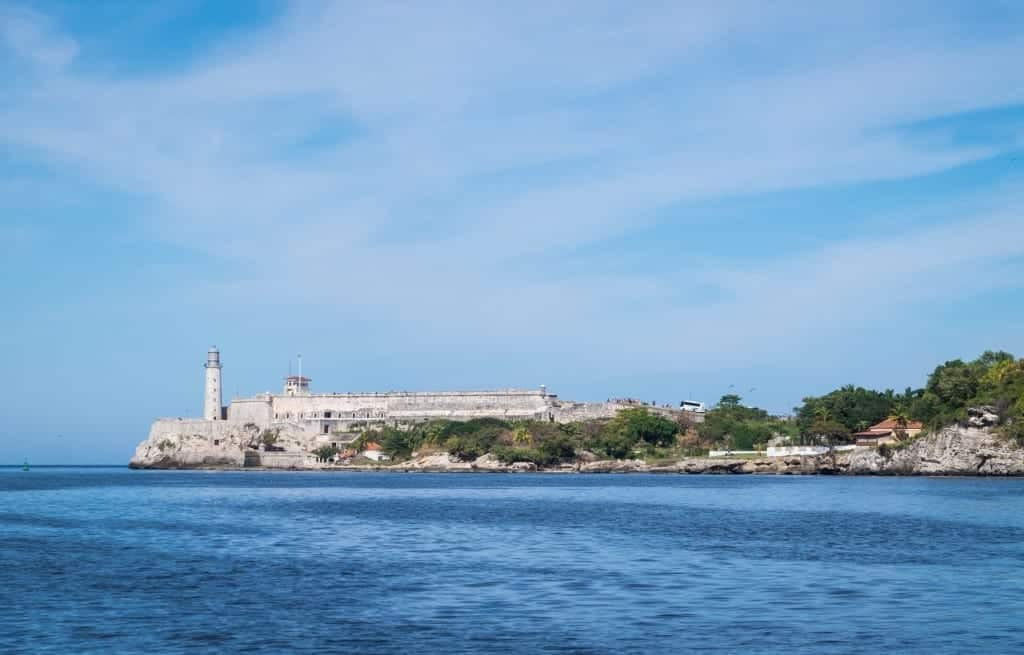 A picturesque lighthouse stands tall against the ocean backdrop in Havana, under a clear blue sky.
A picturesque lighthouse stands tall against the ocean backdrop in Havana, under a clear blue sky.
How Americans Can Secure a Cuban Visa
For Americans aiming to visit Cuba legally, obtaining a Cuban visa, officially termed a “general license,” beforehand is essential. The Cuban government mandates this for all travelers to Cuba. While the terminology might seem slightly complex, understanding it as a general license simplifies the process.
The Office of Foreign Assets Control (OFAC) outlines 12 authorized categories for travel to Cuba under a general license:
- Family Visits
- US Government, Foreign Government, and Intergovernmental Organizations Official Business
- Journalistic Activities
- Professional Research and Meetings
- Educational Activities
- Religious Activities
- Public Performances, Workshops, Competitions, and Exhibitions
- Support for the Cuban People
- Humanitarian Projects
- Private Foundations, Research, or Educational Institutes Activities
- Exportation, Importation, or Transmission of Information
- Authorized Export Transactions
The “People-to-People Activities” category, previously under “Educational Activities” and a straightforward option for many, was eliminated by the Trump administration.
While joining a tour group can be an enjoyable way to experience Cuba, many international tour operators exclude American citizens due to licensing complexities. However, specialized Cuba tour operators exist that cater to Americans, often structuring trips to comply with categories like journalistic or religious activities, handling the necessary documentation.
Cuba cruises, once a growing trend, are currently on hold. Cruise lines are not operating routes to Cuba due to various factors, including the evolving travel landscape post-COVID. Whether cruise travel to Cuba will resume in the future remains to be seen.
The Most Convenient Way to Obtain a General License
For the average American tourist seeking to explore Cuba, securing a general license under the “Support for the Cuban people” category is highly recommended. This approach mirrors the ease of traveling with a specialized tour operator and can be effortlessly facilitated through services like ViaHero.
ViaHero specializes in crafting personalized trip itineraries, designed by local experts. While their services span numerous destinations, they are particularly adept at Cuba travel, ensuring your itinerary aligns with the requirements for the “Support for the Cuban People” general license. A ViaHero itinerary serves as valid documentation for this travel category.
A significant advantage of using ViaHero is their ability to manage your transportation within Cuba, often a challenging aspect for independent travelers. They also provide comprehensive guidance on obtaining your Cuban visa. You can explore their services further here.
With a Cuban visa in hand, direct flights from the US to Cuba become an option! Flights are available from major US cities like Miami, New York, Fort Lauderdale, and Atlanta, even on airlines like American Airlines. Skyscanner is a reliable platform for finding affordable flights from the US to Cuba, as some booking sites may not display Cuba flights.
For those flying from the US to Cuba, the “pink tourist card” is a necessary document, obtainable at the airport during check-in or at your airline’s ticket counter. While it’s possible to purchase it in advance, it’s generally not necessary and avoids potentially unnecessary processing fees.
It’s important to note the distinction between tourist cards: travelers from the US require the pink card, while those arriving from other countries need the green tourist card.
For travelers with a visa flying to Cuba via another country like Mexico or Canada, the green Cuban tourist card is required instead. We’ll delve into this alternative route next.
Visiting Cuba Without a Visa: An Alternative for Americans
Another way for Americans to visit Cuba involves a somewhat less direct, though commonly practiced, approach: flying to Cuba from a third country. This method operates in a legal gray area but remains a popular choice. Cancún, Mexico, is a frequently chosen gateway, offering often inexpensive flights to Cancún and short flights (just over an hour) from Cancún to Havana.
Flights to Havana are also available from other Mexican cities like Mexico City and Mérida, as well as Canadian cities such as Toronto. Skyscanner is again a useful resource for finding cost-effective flights to Cuba via these routes, as some flight search engines may not list Cuba-bound flights.
Opting for this route means you won’t need to secure a Cuban visa beforehand. The essential document becomes the Cuban tourist card, often referred to as the “green tourist card.” This card is purchased at the airport of your departure to Cuba, typically at the airline’s ticket counter.
For example, at Cancún airport, Interjet (or the airline operating your flight to Cuba) sells tourist cards at the check-in area for Havana flights, usually priced around $25 USD.
It’s important to note that Cuban immigration authorities primarily focus on the tourist card, not whether you possess a US visa. Your method of arrival—with or without a US visa—is generally not a concern for them. Furthermore, Cuba respects traveler preferences regarding passport stamps and will refrain from stamping your passport if you request it.
Essential Information for Americans Traveling to Cuba
Travel insurance is a mandatory requirement for entering Cuba. While you may not always be asked to present proof (I wasn’t), it’s prudent to have a printed copy readily available.
Restrictions on Spending: Americans are prohibited from financial transactions with Cuban entities on the US State Department’s restricted list. This list includes numerous government-owned hotels, so verifying your accommodation against this list before booking is crucial. The complete list is accessible here.
Receipt Keeping: It’s advisable to retain all receipts from your Cuba trip for up to five years after your return. The US government reserves the right to request these as proof of authorized travel activities.
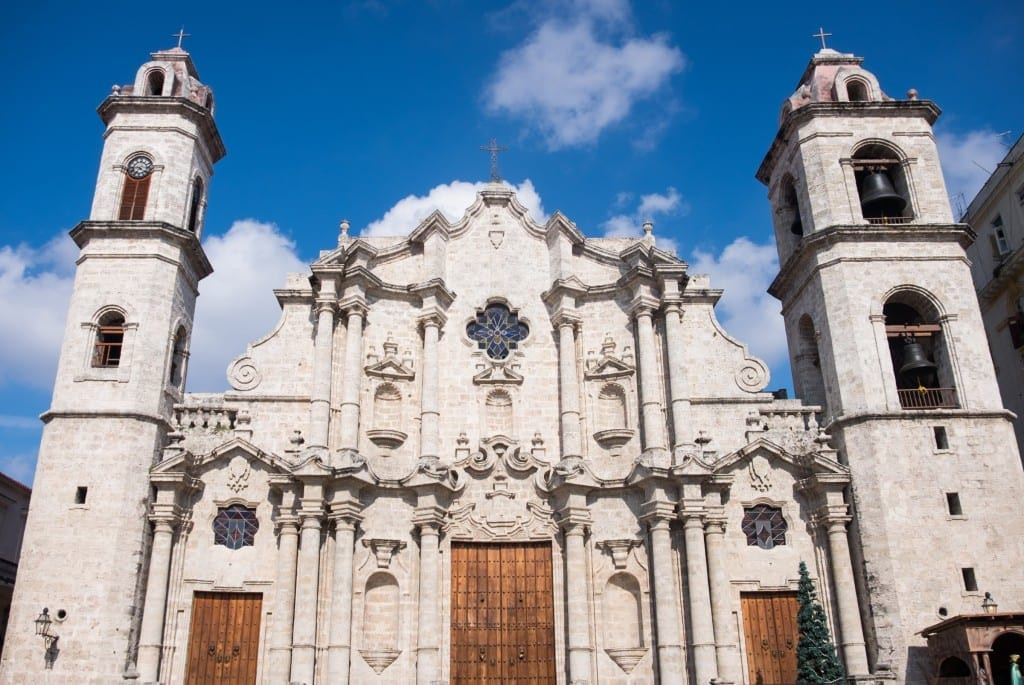 A charming church stands in Old Havana, framed against a clear blue sky.
A charming church stands in Old Havana, framed against a clear blue sky.
Managing Money in Cuba as an American Traveler
Traveling to Cuba as an American presents unique financial considerations. Due to US regulations, Americans cannot conduct financial transactions in Cuba through conventional means. ATMs, debit cards, and credit cards issued by US banks are non-functional, even with a valid visa. This necessitates bringing enough cash to cover your entire trip expenses.
On my trip to Cuba, I had a slight financial safety net. Traveling with my boyfriend Charlie, a British citizen, and our friend Klara, a Czech-Canadian dual citizen, meant they had access to ATMs and credit cards. However, we soon discovered that even for non-Americans, ATMs in Cuba aren’t always reliable. Charlie, arriving a day earlier, found that ATMs in Havana were consistently out of service, regardless of the card used. After numerous attempts at various ATMs, a quick message via a Wi-Fi hotspot to Klara – “BRING 400 EUROS, NONE OF THE ATMS ARE WORKING!!” – led to a successful withdrawal at another ATM.
It turns out that Cuban ATMs can be particularly finicky with MasterCards. This experience underscores the importance of having ample backup cash, irrespective of your nationality, when traveling to Cuba.
So, how should American travelers manage finances in Cuba? Bringing US dollars or Euros to exchange upon arrival is the most practical approach.
While historically, US dollars received a less favorable exchange rate, as of early 2024, both US dollars and Euros are exchanged at comparable rates. Contrary to my expectations, exchange bureaus are not readily visible in Havana.
Currency exchange primarily occurs at banks in Cuba, often involving lengthy queues. The most convenient option is usually exchanging money at your accommodation. Airport exchanges are also available but typically offer less favorable rates.
For solo American travelers, or those traveling only with other Americans, a crucial tip is to keep enough US dollars concealed for transportation to Havana Airport and a flight to Cancún at all times. This provides a financial emergency exit strategy. While I’ve never adopted such measures in my travels before, Cuba warrants this level of precaution due to the lack of a financial safety net.
Given the necessity of carrying substantial cash, secure storage is paramount. I highly recommend using a Speakeasy Travel Supply scarf, featuring a hidden pocket ideal for concealing cash and available in lightweight fabrics suitable for Cuba’s climate. (I even have my own design!).
A portable safe is also an invaluable asset. My Pacsafe Travelsafe is an essential packing item.
Consider discreetly hiding cash in various luggage compartments. Unused sanitary products, like maxi pads or tampon applicators, can serve as surprisingly effective hiding spots, often overlooked due to social taboos.
Cuba operates with two currencies: the Cuban Convertible Peso (CUC) and the Cuban National Peso (CUP). Tourists primarily use CUC, which is pegged to the US dollar. CUP is valued at approximately 24 to 1 CUC and is mainly used by locals.
Distinguishing between the currencies is simple: CUC notes feature monuments, while CUP notes depict faces.
Ensure you exchange all Cuban currency back before departing Cuba, as it cannot be exchanged at US banks or currency exchange services.
Accommodation Options in Cuba
While hotels are present in Cuba, particularly larger chains and beach resorts, for a more authentic and economically impactful experience, consider staying in casas particulares.
Casas particulares are private rooms or apartments within Cuban homes, rented out to travelers. Often very affordable, typically around $25 per room, which is what I paid for a one-bedroom in Viñales, and $50 for a two-bedroom in Havana.
Both of my casa particular stays were exceptional. In Havana, I stayed in this two-bedroom, two-bathroom apartment near Old Havana for $50 a night. It was spacious and felt like a peaceful retreat, though a bit noisy due to street traffic, easily managed with earplugs.
In Viñales, I chose this one-bedroom suite in a casa particular in town. It was roomy, with rocking chairs on the front porch, offering a tranquil countryside setting.
Airbnb is a useful platform for finding casas particulares. Explore options in Havana here.
A significant advantage of casas particulares is the networking and support they offer. Looking to travel to Trinidad or Cienfuegos next? Your casa host can arrange accommodations at your next destination through their local network, often including transportation.
My casa hosts also facilitated onward travel, tours, currency exchange, and provided drinking water, showcasing the interconnectedness and resourcefulness of Cuban communities.
This network of personal connections was one of the most rewarding aspects of my Cuban experience.
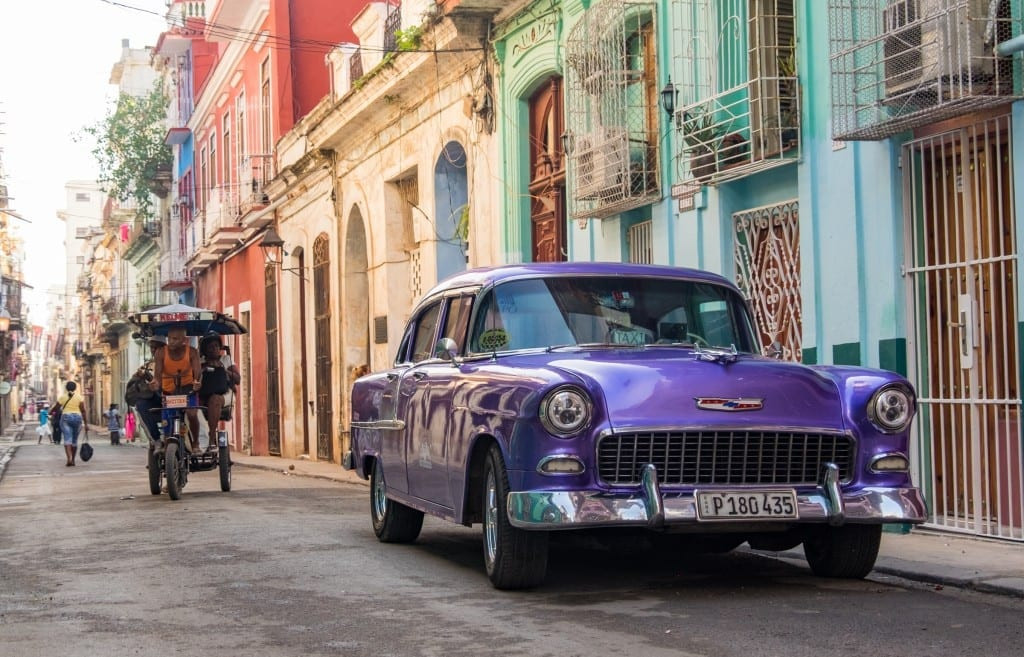 A vibrant purple classic car parked on a colorful street in Havana.
A vibrant purple classic car parked on a colorful street in Havana.
Experiencing Havana: First Impressions
What comes to mind when you picture Cuba? Classic cars, colonial architecture, salsa music, and vibrant beaches? Havana embodies many of these iconic images, but with its own distinct character.
Here are some of my observations from Havana:
Diversity of Cuban People: Cuba’s population is incredibly diverse, reflecting a rich blend of backgrounds and ethnicities. As highlighted in the film Moonlight, Cuba has a significant Afro-Cuban population, alongside influences from Italian, Ecuadorian, Scandinavian, and even Chinese communities. There’s no single “Cuban look.”
The Reality of Classic Cars: The legendary classic cars of Cuba are indeed a prominent feature. From Russian Ladas to meticulously maintained vintage American vehicles, the streets are a living automotive museum. The most pristine classics often serve as taxis for tourists. However, alongside these gems, you’ll also see older, more utilitarian cars. Unfortunately, the exhaust from these older vehicles contributes to air pollution.
Distinct Cuban Spanish Accent: The Cuban accent is unique, differing from other Spanish dialects. The letter ‘s’ is often dropped, transforming words like “Viñales” into “bin-yallih” and “más” into “ma.”
Cuban Rum Culture: Havana Club rum is deeply ingrained in Cuban culture. While Cuban rum might be an exotic import elsewhere, in Cuba, it’s simply part of daily life. You can explore the Museo del Ron or simply enjoy a cocktail at a local bar. I recommend trying a Havana Special cocktail, or a creamy piña colada at El Louvre Bazar.
Street Vegetable Carts: Mobile vegetable carts are a common sight in Havana, predominantly stocked with onions, peppers, and tomatoes. Variety is limited, with occasional offerings of sweet potatoes or garlic.
NBA Jersey Popularity: NBA jerseys, particularly Michael Jordan and LeBron James jerseys, are surprisingly prevalent among Cubans. Basketball seems to overshadow baseball in terms of merchandise visibility.
Sparse Grocery Stores: Cuban grocery stores often have sparsely stocked shelves, reminiscent of pre-storm bread aisles. Variety is limited, with rows of identical items rather than diverse brands. Unsurprisingly, American brands are absent.
Treatment of Dogs: I observed instances of harsh leash handling of dogs, which was disheartening.
Cuban Musicality and Talent: Many Cubans possess remarkable musical talent and a zest for life, often expressed through music and dance. Even casual bar bands can deliver exceptional performances.
These are just initial observations. To truly understand Cuba, engaging in conversations with Cubans is essential.
Engaging in Cuban Conversations
A vibrant pink Corvette taxi dropped us off at a brightly colored building in Central Havana for a highly-rated Airbnb Experience: a seafood cooking class.
Odalys, our host, greeted us with prepped vegetables and showcased three impressive lobsters. We were to learn to make lobster enchiladas, a Cuban interpretation distinct from the typical tortilla-based dish. Her friend Ivan served as our translator. “Cut the vegetables small,” he instructed.
 Three pairs of hands diligently chop lobster and vegetables, preparing for a Cuban cooking class.
Three pairs of hands diligently chop lobster and vegetables, preparing for a Cuban cooking class.
We each took on vegetable chopping – peppers for me, garlic for Charlie, onions for Klara. Odalys then demonstrated preparing the lobster, including removing the intestine—a step new even to a New Englander familiar with lobsters!
We stewed the lobster with the diced vegetables in a tomato and cayenne pepper sauce. The familiar combination of onions, peppers, and tomatoes struck me – the same base as ropa vieja and another shrimp dish we’d had.
It dawned on me: onions, peppers, and tomatoes – repeatedly. These limited vegetables on the street carts might dictate much of Cuban cuisine due to limited access to other produce. This realization was impactful – imagine culinary creativity within such constraints.
As the lobster simmered, we prepared tostones and enjoyed rum with lime. Ivan, translating Odalys’s instructions, casually used his phone – a contrast to typical Cuban internet usage focused on conserving data. He explained he had a new 4G package, recently available to locals.
We complimented Ivan’s English, including his use of idioms. “I watch Kimmel, Trevor Noah,” he replied, explaining his language learning through the weekly package, El Paquete Semanal. This unique Cuban system delivers a terabyte of data – TV shows, movies, apps – offline, distributed via networks across the island for about $1. It’s internet, without the internet, a testament to Cuban ingenuity in connecting with the world.
The lobster enchiladas, when ready, were exceptional – fresh lobster in a perfectly spiced tomato sauce, accompanied by tostones, rice, and tomatoes. The best meal of my Cuba trip.
Over dinner, fueled by rum, I asked Ivan a question that had been on my mind: “How do Cubans feel about US citizens?”
“Of course, we like Americans,” he responded, easing my apprehension. “We just don’t like your president.”
“Makes two of us,” I replied. “Were you happy when Obama came to Cuba?”
“Obama was more of the same,” he stated.
“More of the same? He did more to open Cuba than any president,” I countered.
“It made no difference to us,” he reiterated, a perspective that resonated deeply.
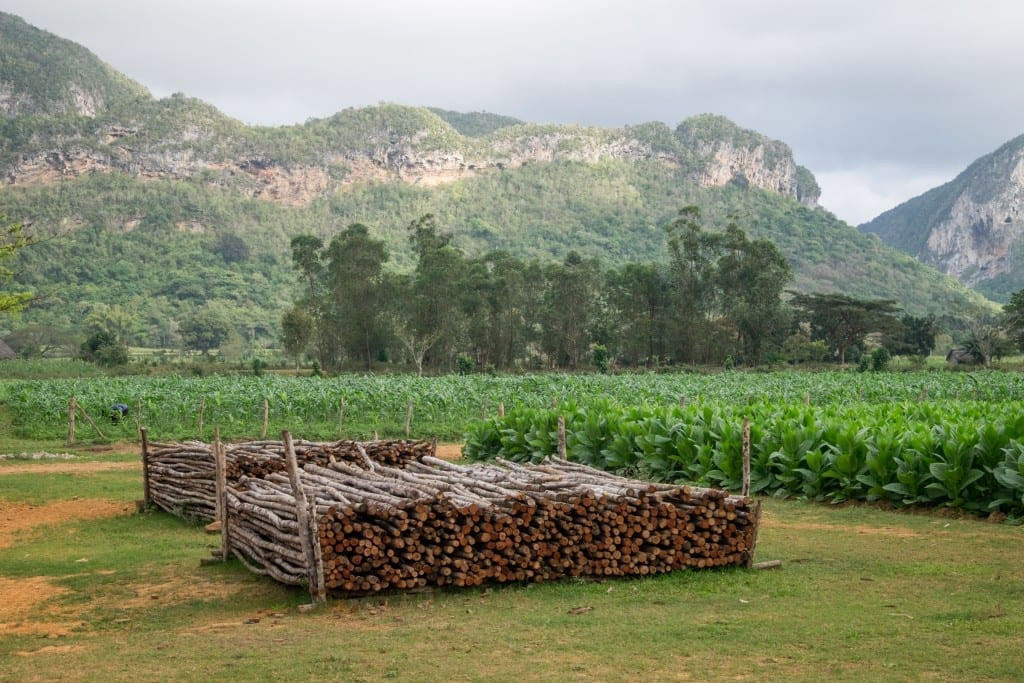 Stacks of wood in Viñales, with mountains and tobacco fields in the background.
Stacks of wood in Viñales, with mountains and tobacco fields in the background.
Airbnb in Cuba and Economic Opportunities
In 2022, the average monthly salary in Cuba was around $175 USD. This stark economic reality underscores the critical role of tourism, particularly direct engagement with local businesses, in improving Cuban livelihoods.
I was impressed by Odalys’s entrepreneurial spirit. Beyond cooking classes, she and her husband rented rooms and cultivated partnerships to bring visitors to their home. This hustle is essential for economic survival and success in Cuba.
Our Havana apartment owner, Gladys, also exemplified this entrepreneurial approach, offering services like drinking water and currency exchange to supplement her income.
Odalys’s cooking class, priced at $39 per guest, likely yields a significant profit after expenses, especially considering the potential volume of bookings.
While Airbnb has faced criticism in many cities for contributing to housing shortages and regulatory issues, in Cuba, it presents a vital economic lifeline for locals facing limited earning opportunities.
In Cuba’s context, Airbnb offers significant economic empowerment, though the sustainability of tourism-dependent incomes remains a concern for 2024 and beyond.
Navigating Internet Access in Cuba
The term “free Wi-Fi” has a different connotation in Cuba. While signs advertising “free Wi-Fi” are common, it usually means a Wi-Fi hotspot is available, but you’ll need to use pre-purchased Wi-Fi cards to access it.
Wi-Fi cards are available at Etecsa stores and some hotels, costing around $1 per hour. Street vendors also sell them at a premium, offering convenience over queuing at official stores.
Wi-Fi hotspots are easily identifiable by groups of people concentrated in areas, engrossed in their devices. Popular spots include outside Hotel Ingleterra in Old Havana, Etecsa stores, and some parks.
Occasionally, you might find locations offering Wi-Fi without card login, but these are rare.
Surprisingly, my American AT&T phone plan had service in Cuba, though data was not functional. Voice and text rates were exorbitant.
Crucially, avoid accessing banking websites or apps, including PayPal and Venmo, while in Cuba. Doing so risks account freezes, which can create significant complications upon returning home.
 Refreshing mojitos served at a bar in Cuba.
Refreshing mojitos served at a bar in Cuba.
Karaoke Adventures in Cuba
Karaoke isn’t a widespread pastime in Cuba, but my friend Harvey, a karaoke enthusiast who has sung in 65 countries, managed to find a spot: La Esencia in Vedado, with karaoke on Wednesday nights.
Harvey, using Google Translate, announced his 65th country karaoke milestone to the locals and launched into “La Bamba,” to enthusiastic cheers and photos from the Cuban patrons.
The rest of us joined in, with varying degrees of success. However, the real entertainment was the English karaoke songbook, hilariously disorganized, creating absurd artist-song pairings. Some gems included:
- Bob Marley singing Shania Twain’s “Man! I Feel Like a Woman”
- Tom Jones belting out Britney Spears’ “Oops, I Did It Again”
- Janis Joplin tackling the Village People’s “YMCA”
- Barbra Streisand rocking AC/DC’s “You Shook Me All Night Long”
- Coolio covering Christina Aguilera’s “Genie in a Bottle”
- Ray Charles grooving to Reel 2 Real’s “I Like to Move It Move It”
- Whitney Houston serenading to David Lee Roth’s “Just a Gigolo”
- John Denver protesting with Pink Floyd’s “Another Brick in the Wall”
- Tony Bennett confessing to Madonna’s “Like a Virgin”
- And finally, Shania Twain howling Baha Men’s “Who Let the Dogs Out?”
The sheer absurdity of these combinations had us in tears of laughter.
The Challenges of Traveling in Cuba
Honesty compels me to admit that after the initial days, I found Cuba challenging and didn’t fully enjoy it, despite wanting to.
Daily life in Havana, especially Old Havana, felt stressful. Constant taxi offers, frequent catcalling when alone, and treacherous sidewalks demanded constant vigilance. The city was noisy, hot, and often filled with unpleasant odors. Classic cars, while visually appealing, contributed to significant air pollution.
Finding good food in Havana proved difficult. The countryside generally offers better culinary experiences. While my friend Ayngelina’s Havana restaurant guide was helpful, many meals were disappointing. Even a decent breakfast spot we found was inexplicably closed for the rest of our trip.
Everything seemed to involve extra effort and hassle. Bus ticket mishaps, the constant need to navigate cash transactions, and the general wear and tear of the city contributed to a sense of unease. I often needed to retreat to my apartment for respite.
The vulnerability of being an American in Cuba, particularly concerning financial emergencies, was a persistent worry.
It wasn’t the hardship itself that was off-putting; I’ve enjoyed challenging destinations like Lebanon and Albania. Nor was it the lack of internet, which I welcomed as a digital detox, having even enjoyed internet-free travel in Antarctica and remote Guyana.
The disparity between the warmth of the Cuban people and music, and the overall difficulties of travel in Cuba, created a complex and somewhat disappointing experience. Conversations with other seasoned travelers revealed similar sentiments about Cuba.
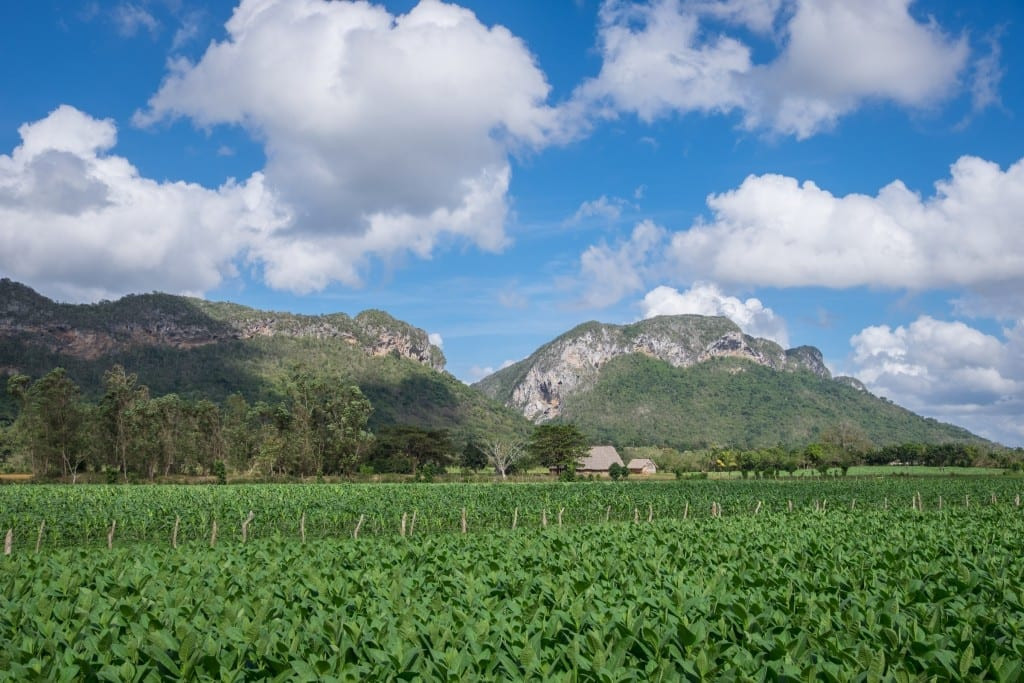 Lush tobacco fields and mountains under a blue sky in Viñales, Cuba.
Lush tobacco fields and mountains under a blue sky in Viñales, Cuba.
Viñales: A Cuban Highlight
Just as my Cuba trip seemed to falter, Viñales emerged as a saving grace. This verdant region offered a welcome respite.
Travel between Cuban cities often involves buses or colectivos (shared taxis). Buses to Viñales were fully booked, so we opted for a colectivo, arranged by a taxi driver. The pickup point was a less-than-charming, garbage-strewn area outside the bus station.
After a 45-minute wait amidst the smells, we were directed to a red classic car packed with travelers. My front middle seat offered an intimate, if slightly cramped, view of the journey. The drive through winding mountain roads revealed stunningly lush scenery, reminiscent of Thailand’s karsts, surrounded by vibrant tobacco fields.
Viñales town is small, filled with casas particulares, restaurants, and bars. While touristy, it felt more relaxed and manageable than Havana. Bars like 3 Jotas (now Bar Tapas 3J) offered a fun, laid-back atmosphere.
The next day, we explored the area with Osniel, an English teacher and local guide from our casa, and two French travelers. While horseback riding is popular, we chose to walk.
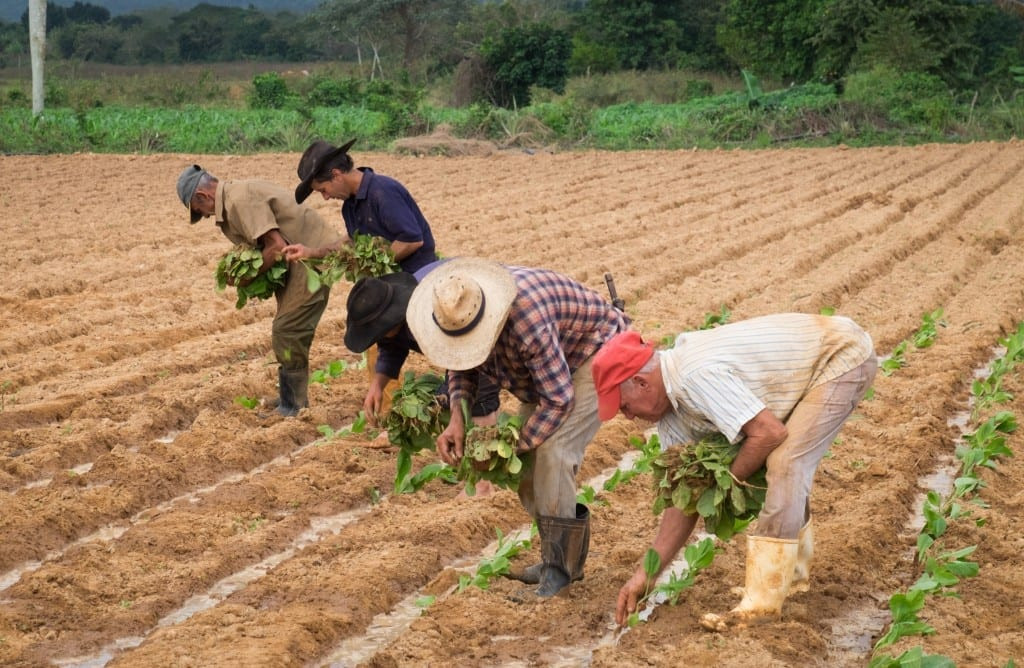 Farmers diligently work in the tobacco fields of Viñales.
Farmers diligently work in the tobacco fields of Viñales.
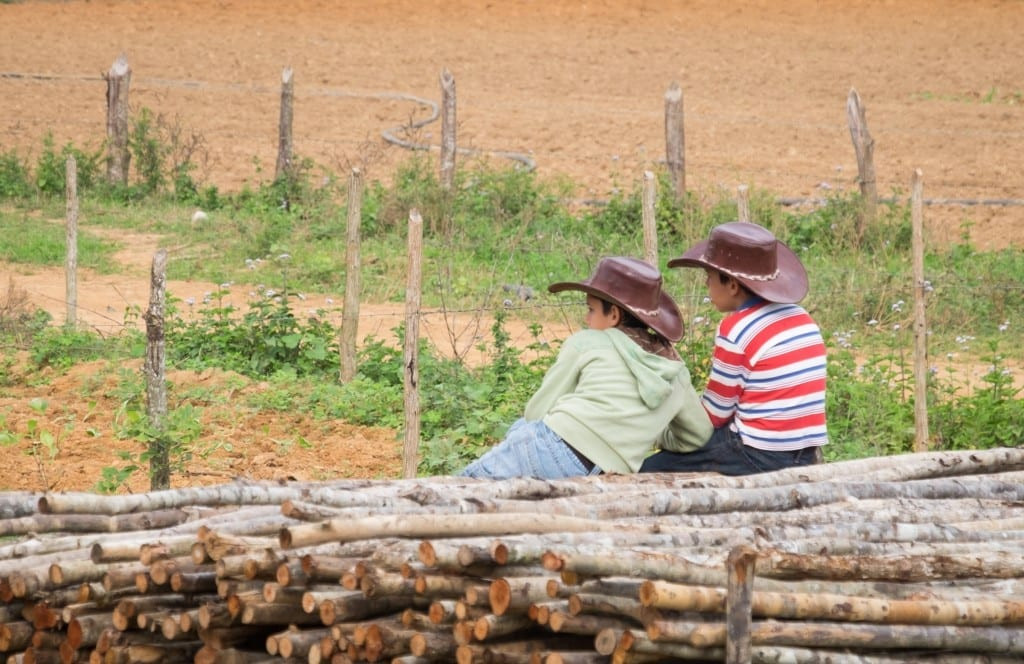 Two young boys in cowboy hats sit on stacks of wood in Viñales, enjoying the rural scenery.
Two young boys in cowboy hats sit on stacks of wood in Viñales, enjoying the rural scenery.
A walk along orange dirt paths led to a tobacco farm, the primary crop in the region since the 1959 revolution. Farmers retain only 10% of their produce, with the government taking the rest. Tourism has become a significant economic supplement.
At the farm, we enjoyed juices and learned about coffee and rum production, with opportunities to purchase local products. The atmosphere was relaxed and welcoming. A pregnant dog and a tiny, vocal kitten named Montecristo added to the charm.
We hiked past more mountains to a cave, and after lunch at the farm, returned to town. That evening, we savored ropa vieja, a dish that tasted far superior to my home-cooked attempts, the beef slow-cooked with the essential Cuban trio: onions, peppers, and tomatoes.
Viñales was a highlight, a joyful contrast to the challenges of Havana.
Cuba Travel: Key Takeaways
Osniel arranged our return transport – another classic car – to Havana Airport. Looking at the departures board, I was struck by the number of US destinations – Miami, New York, Atlanta – and how unaware many are that these direct flights are possible.
The US travel ban to Cuba feels increasingly unjustified. It’s a decades-old policy that serves little purpose today. Having traveled extensively, I’ve seen the US maintain close ties with countries with far more questionable human rights records than Cuba.
Cuba poses no threat. The embargo is ineffective and outdated.
If the US government sought to address countries genuinely detrimental to US interests, Russia, for its aggression in Ukraine and election interference, or Saudi Arabia, for its links to 9/11 and human rights abuses, would be more logical targets.
Even China and Myanmar, facing accusations of genocide, are more easily accessible than Cuba.
I hope President Biden builds upon Obama’s steps towards normalizing relations and allows for genuine reconnection between our nations.
For future Cuba travel, I’d recommend a shorter Havana stay – two full days maximum, perhaps in a less chaotic neighborhood like Vedado.
Would I return to Cuba? I’m uncertain. While Viñales and some beach areas were appealing, the overall experience, as echoed by my friend Klara, was often a hassle.
Landing back in Mexico City brought a wave of relief. Excitement for tacos and reliable internet was secondary to the sense of financial security restored. The underlying unease of Cuba travel dissipated.
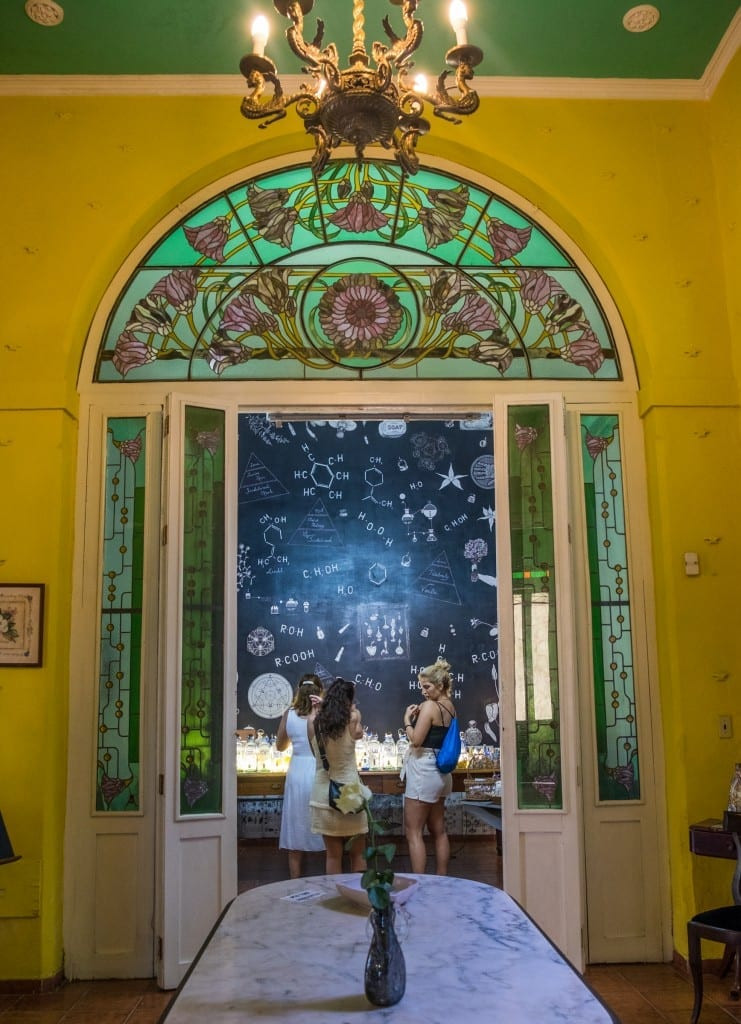 Stunning green and purple stained glass windows at the Museum of Perfume in Havana.
Stunning green and purple stained glass windows at the Museum of Perfume in Havana.
A Post-Cuba Banking Caution
Back in Mexico, reimbursing Charlie for trip expenses, I innocently wrote “CubaMerida” in the transaction memo. Mistake.
Typically, my bank transfers are instant, but this one was delayed, with an email citing extended processing. Then came another email: why “Cuba” in the memo? Was I spending money in Cuba?
Oops.
I replied, explaining it was for photography reimbursement (true, Charlie took many photos on this page).
The bank followed up, noting a previous transaction memo “flights.” “Did you also pay for flights to Cuba?”
Argh. No, those were unrelated flights.
I forwarded flight confirmations to Prague and back, the actual flights reimbursed earlier.
Sharing this on Facebook, I was met with similar stories – mentioning “Cuba” anywhere can trigger scrutiny. One friend’s Venmo was frozen for a “Cuban sandwich” reimbursement!
Lesson learned: Americans can fly to Cuba, but post-trip discretion is advised.
More about Cuba:
Explore more of the Caribbean:
Essential Travel Information
For Americans traveling to Cuba, I highly recommend securing a visa through ViaHero. They create custom itineraries, handle complex bookings, and ensure your trip aligns with the “Support for the Cuban People” visa category. Learn more here.
In Havana, I stayed at this two-bedroom apartment near Old Havana, a great oasis despite street noise (earplugs recommended). Find more Havana accommodations here.
My highly recommended Havana cooking class with Odalys, booked via Airbnb Experiences, was a highlight at $39 per person.
For Havana dining, Ayngelina’s restaurant guide is invaluable. Paladar Omar and Genesis were excellent.
In Viñales, this casa particular suite was excellent at $25/night (plus $5 breakfast). Explore more Viñales options here. Tours can be booked through casa hosts like Osniel.
Travel insurance is mandatory for Cuba. Ensure your policy covers Cuba travel. (Note: World Nomads no longer covers Cuba).
Have you been to Cuba? Share your experiences and thoughts below!